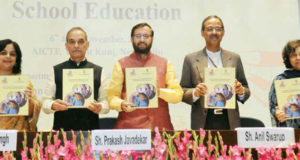
Two major initiatives as part of ‘‘Ayushman Bharat’’ programme are aimed at making path breaking interventions to address health holistically, in primary, secondary and tertiary care system covering both prevention and health promotion.
 A run Jaitley’s Health Budget marks a positive and dynamic milestone in the history of India for some of the landmark proposals in the Budget 2018 among other major ones like the announcement of world’s largest Health Protection Scheme covering over 10 crore poor and vulnerable families launched with a family limit upto 5 lakh rupees for secondary and tertiary treatment. Hike in deduction limit for health insurance premium and/ or medical expenditure from Rs. 30,000 to Rs. 50,000 under section 80D.
A run Jaitley’s Health Budget marks a positive and dynamic milestone in the history of India for some of the landmark proposals in the Budget 2018 among other major ones like the announcement of world’s largest Health Protection Scheme covering over 10 crore poor and vulnerable families launched with a family limit upto 5 lakh rupees for secondary and tertiary treatment. Hike in deduction limit for health insurance premium and/ or medical expenditure from Rs. 30,000 to Rs. 50,000 under section 80D.
Increase in deduction limit for medical expenditure for certain critical illness from Rs. 60,000 (in case of senior citizens) and from Rs. 80,000 (in case of very senior citizens) to Rs. 1 lakh for all senior citizens, under section 80DDB.
Indian economy has performed very well since our Government took over in May, 2014. India achieved an average growth of 7.5% in first three years of our Government. Indian economy is now 2.5 trillion dollar economy – seventh largest in the world. India is expected to become the fifth largest economy very soon. On Purchasing Power Parity (PPP) basis, the Finance Minister remarked that we are already the third largest economy.
He explained that Indian society, polity and economy had shown remarkable resilience in adjusting with the structural reforms. GDP growth at 6.3% in the second quarter signaled turnaround of the economy. We hope to grow at 7.2% to 7.5% in the second half. IMF, in its latest Update, has forecast that India will grow at 7.4% next year. Manufacturing sector is back on good growth path. The services, mainstay of our growth, have also resumed their high growth rates of 8% plus. Our exports are expected to grow at 15% in 2017-18. We are now firmly on course to achieve high growth of 8% plus.
Government is providing free LPG connections to the poor of this country through Ujjwala Yojana. Under Saubhagya Yojna 4 crore household are being provided with electricity connections. More than 800 medicines are being sold at lower price through more than 3 thousand Jan Aushadhi Centres. Cost of stents have been controlled. Special scheme for free dialysis of poor have been initiated. Persons belonging to poor and middle class are also being provided a great relief in interest rates on housing schemes. Efforts are being made to provide all government services, whether bus or train tickets or individual certificates on line. These include passports which may be delivered at doorstep in two or three days or Company registration in one day time and these facilities have benefited a large section of our country. Certificate attestation is not mandatory, interviews for appointment in Group C and Group D posts have been done away with. These measures have saved time and money of lakhs of our youth. Government by using modern technology is committed to provide a relief to those who suffer because of rigid rules and regulations.
While undertaking these reforms and programmes, Government has worked sincerely and without weighing the political costs. Government has ensured that benefits reach eligible beneficiaries and are delivered to them directly. Many services and benefits are being delivered to the people at their doorsteps or in their accounts. It has reduced corruption and cost of delivery and has eliminated middlemen in the process. Direct Benefit Transfer mechanism of India is the biggest such exercise in the world and is a global success story.
Prime Minister’s Ujjwala Scheme was launched to make poor women free from the smoke of wood. Initially the target was to provide free LPG connections to about 5 crore poor women. But in view of the pace of implementation of Ujjwala scheme and its popularity among the women, it was proposed to increase the target of providing free connection to 8 crore poor women.
Government has launched Prime Minister Saubhagya Yojana for providing electricity to all households of the country. Under this scheme, four crores poor households are being provided with electricity connection free of charge. The government is spending Rs 16000 crore under this scheme. Swachh Bharat Mission has benefited the poor. Under this mission, Government has already constructed more than 6 crore toilets. The positive effect of these toilets is being seen on the dignity of ladies, education of girls and the overall health of family. Government is planning to construct around 2 crore toilets.
Government is implementing a comprehensive social security and protection programme to reach every household of old, widows, orphaned children, divyaang and deprived as per the Socio-Economic Caste Census. Allocation on National Social Assistance Programme this year has been kept at Rs 9975 crore.
Government has managed to get children to school but the quality of education is still a cause of serious concern. Learning outcomes have now been defined and National Survey of more than 20 lakh children has been conducted to assess the status on the ground. This will help in devising a district-wise strategy for improving quality of education. It is now proposed to treat education holistically without segmentation from pre-nursery to Class 12.
Improvement in quality of teachers can improve the quality of education in the country. The government will initiate an integrated B.Ed. programme for teachers. Training of teachers during service is extremely critical. The government has amended the Right to Education Act to enable more than 13 lakh untrained teachers to get trained.
Technology will be the biggest driver in improving the quality of education. It has been proposed to increase the digital intensity in education and move gradually from ‘‘black board’’ to ‘‘digital board’’. Technology will also be used to upgrade the skills of teachers through the recently launched digital portal ‘‘DIKSHA’’.
The Government is committed to provide the best quality education to the tribal children in their own environment. To realise this mission, it has been decided that by the year 2022, every block with more than 50% ST population and at least 20,000 tribal persons, will have an Ekalavya Model Residential School. Ekalavya schools will be on par with Navodaya Vidyalayas and will have special facilities for preserving local art and culture besides providing training in sports and skill development.
To step up investments in research and related infrastructure in premier educational institutions, including health institutions, Government proposes to launch a major initiative named ‘‘Revitalising Infrastructure and Systems in Education (RISE) by 2022’’ with a total investment of Rs 1,00,000 crore in next four years. Higher Education Financing Agency (HEFA) would be suitably structured for funding this initiative.
Government has taken major initiative of setting up Institutes of Eminence. There has been tremendous response to this initiative by institutions both in public and private sectors. Government has received more than 100 applications. Steps have also been taken to set up a specialized Railways University at Vadodara. Two new full-fledged Schools of Planning and Architecture have proposed to be set up, to be selected on challenge mode. Additionally, 18 new SPAs would be established in the IITs and NITs as autonomous Schools, also on challenge mode.
The Government would launch the ‘‘Prime Minister’s Research Fellows (PMRF)’’ Scheme this year. Under this, 1,000 best B.Tech students will be identified each year from premier institutions and provide them facilities to do Ph.D in IITs and IISc, with a handsome fellowship. It is expected that these bright young fellows would voluntarily commit few hours every week for teaching in higher educational institutions.
Swasth Bharat can be a Samriddha Bharat. India cannot realize its demographic dividend without its citizens being healthy. Two major initiatives as part of ‘‘Ayushman Bharat’’ programme are aimed at making path breaking interventions to address health holistically, in primary, secondary and tertiary care system covering both prevention and health promotion.
The National Health Policy, 2017 has envisioned Health and Wellness Centres as the foundation of India’s health system. These 1.5 lakh centres will bring health care system closer to the homes of people. These centres will provide comprehensive health care, including for noncommunicable diseases and maternal and child health services. These centres will also provide free essential drugs and diagnostic services. Finance Minister has committed Rs 1200 crore in this budget for this flagship programme.
Contribution of private sector through CSR and philanthropic institutions has also been invited in adopting these centres. Lakhs of families in the country have to borrow or sell assets to receive indoor treatment in hospitals. Government is seriously concerned about such impoverishment of poor and vulnerable families. Present Rashtriya Swasthya Bima Yojana (RSBY) provide annual coverage of only Rs 30,000 to poor families. Several State Governments have also implemented or supplemented health protection schemes providing varying coverage. Government has now decided to take health protection to more aspirational level.
A flagship National Health Protection Scheme has also been proposed to cover over 10 crore poor and vulnerable families (approximately 50crore beneficiaries) providing coverage upto 5 lakh rupees per family per year for secondary and tertiary care hospitalization. This will be the world’s largest government funded health care programme. Adequate funds will be provided for smooth implementation of this programme. These two far-reaching initiatives under the Ayushman Bharat will build a New India 2022 and ensure enhanced productivity, well- being and avert wage loss and impoverishment. These Schemes will also generate lakhs of jobs, particularly for women. The Government is steadily but surely progressing towards the goal of Universal Health Coverage.
TB claims more lives every year than any other infectious disease. It affects mainly poor and malnourished people. Government has, therefore, decided to allocate additional Rs 600 crore to provide nutritional support to all TB patients at the rate of Rs 500 per month for the duration of their treatment. In order to further enhance accessibility of quality medical education and health care, Government will be setting up 24 new Government Medical Colleges and Hospitals by upgrading existing district hospitals in the country. This would ensure that there is at least 1 Medical College for every 3 Parliamentary Constituencies and at least 1 Government Medical College in each State of the country.
Making villages open defecation free is aimed at improving the life of villagers. Government will launch a Scheme called Galvanizing Organic Bio-Agro Resources Dhan (GOBAR-DHAN) for management and conversion of cattle dung and solid waste in farms to compost, fertilizer, bio-gas and bio-CNG.


























